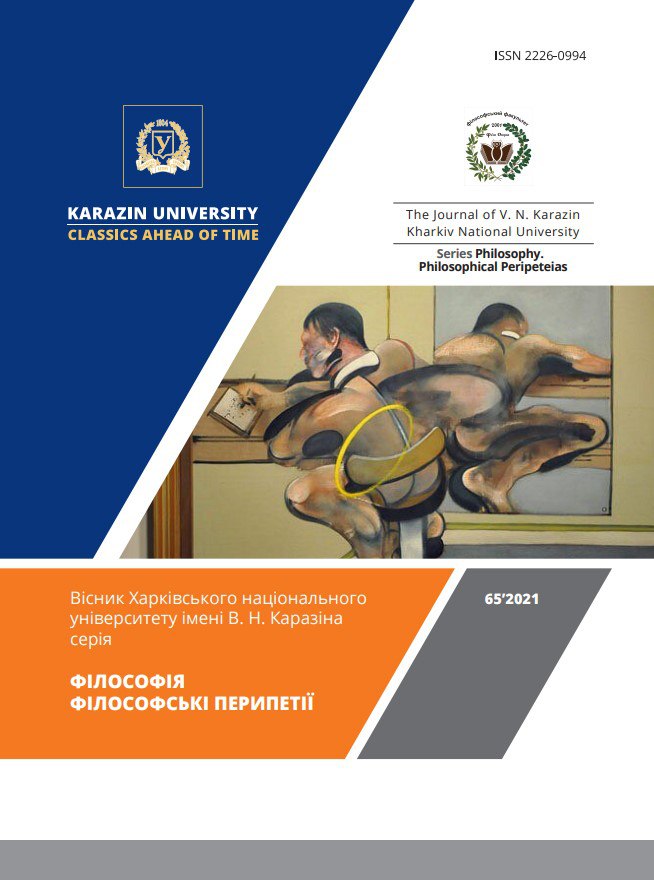POST-POSTMODERN: ARTS AND TRENDS
Abstract
This article considers post-postmodern arts and trends in their diversity. The starting point of the research is the comparison of postmodern and post-postmodern in the art environment. Postmodern paradoxically limits the redundancy, not allowing sufficient displaying of the special features of an art object. Post-postmodern arts provide a possibility to overcome the lack and danger of events and the self-happening of a human being. Object-oriented ontology (OOO) by Graham Harman, performatism by Raoul Eshelman, metamodernism by Timotheus Vermeulen and Robin van den Akker, digimodernism by Alain Kirby, post-postmodern understanding of architecture by Tom Turner, etc. are intellectual trends, which comprehends peculiarities of postmodern and post-postmodern art in particular. OOO displays, that post-postmodern art is rather theatrical that literal and even post-postmodern literature becomes theatrical. The renouncement from an overestimation of both form and function in art, especially in architecture, allows to designate a weird formalism as an actual art position. Since the article deals with the art of living through, the greatest attention is paid to architecture as an exemplary art. This explains the appeal to works that research architecture, including the theories of architects themselves such as Peter Zumthor or Juhani Palasmaa or creating architectural art objects by writers. On the other hand, post-postmodern writers such as David Foster Wallace or Dave Eggers create theatrical literary works, which are often filmed. Performatism as a direction developing post-millennial generative anthropology is the basis for the researching of generative art as the most unpredictable and close to the spontaneity of living through as a moving to attract objects, including art objects. This article develops this approach by researching of moving from self-performance to self-happening as an art of demeanor, a mode of being. Thus, post-postmodern art in its diversity appears as art a human being living through.
Downloads
References
AJ Artemel. (2020, December 1). Peter Versus Peter: Eisenman And Zumthor’s Theoretical Throwdown. Retrieved from https://architizer.com/blog/practice/tools/peter-versus-peter/
AJ Artemel. (2020, December 1). When Writers Become Architects: An Experiment In Space And The Written Word. Retrieved from https://architizer.com/blog/inspiration/industry/when-writers-become-architects/
Eggers, D. (2013). A Heartbreaking Work of Staggering Genius. N.-Y.: Simon & Schuster. Kindle edition.
Eshelman, R. (2008). Performatism, or the End of Postmodernism. Aurora, CO: Davies Group.
Harman, G. (2020). Art and Objects. Cambridge, Polity.
Bedford, J. (ed.) (2020). Is there an Object-Oriented Architecture?: Engaging Graham Harman. Bloomsbury Publishing 2020.
Kirby, A. (2009). Digimodernism: How New Technologies Dismantle the Postmodern and Reconfigure Our Culture. N.-Y.: Continuum Publishing Corporation.
Lispector, C. (2015). Para não esquecer. Rio de Janeiro: Rocco Digital, 2015. Digital resources.
Nixon, Ch. R. (2013). The work of David Foster Wallace and post-postmodernism [Unpublished doctoral dissertation]. The University of Leeds. Retrieved from https://etheses.whiterose.ac.uk/6873/1/DFW%20and%20post-postmodernism.pdf
Pallasmaa, J. (2005). The Eyes of The Skin: Architecture and the Senses. Chichester: Wiley-Academy; Hoboken, NJ: John Wiley & Sons.
Turner, T. (1995). City as Landscape: A Post Post-modern View of Design and Planning. London: Taylor & Francis.
Vermeulen T. & van den Akker, R. (2010). Notes on metamodernism. Journal of Aesthetics & Culture, Volume 2, 1–14. doi.org/10.3402/jac.v2i0.5677
Vida Vendela (2015) The Diver’s Clothes Lie Empty, N.-Y. Ecco / HarperCollins.
Copyright (c) 2021 Наталія Загурська

This work is licensed under a Creative Commons Attribution 4.0 International License.
Authors who publish with this journal agree to the following terms:
- Authors retain copyright and grant the journal right of first publication of this work under the terms of a license Creative Commons Attribution License 4.0 International (CC BY 4.0).
- Authors are able to enter into separate, additional contractual arrangements for the non-exclusive distribution of the journal's published version of the work (e.g., post it to an institutional repository or publish it in a book), with an acknowledgement of its initial publication in this journal.
- Authors are permitted and encouraged to post their work online (e.g., in institutional repositories or on their website) prior to and during the submission process, as it can lead to productive exchanges, as well as earlier and greater citation of published work.






3.gif)




